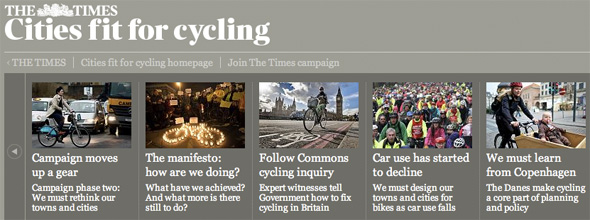So yesterday the Daily News published an opinion piece on bike-share that framed it not as a new option for New Yorkers to get around, but as another tense, dangerous showdown in the eternal confrontation between bikes and cars. Yawn.
Of course, the fact that bike-share systems from London to DC have excellent safety records is anathema to Arthur Browne's editorial page. When you don't actually care about making streets safer for people, this is the kind of stuff you publish:
Bicycling has developed many devoted, if not rabid, supporters.
While they’re to be congratulated for going with a healthful, no-pollution form of transportation, the virtues of their mode of getting around is no free ticket to commandeering the roads.
Like so much else in New York, bicycles versus motor vehicles comes down essentially to a competition for real estate. There is only so much of it between the curbs. Already, the contest is playing out uneasily. Injecting 6,000 additional bikes — eventually 10,000, if all goes to plan — will only heighten the jockeying.
So, too, the dangers.
The opinion writers who've never met a street safety overhaul they like and never make a peep about real dangers like oversize big rigs crushing children on their way to school -- these same guys want to make bike-share out to be a scary thing.
Meanwhile, the Times of London -- which launched a campaign toward the end of 2011 to make cycling safer in British cities -- is cranking out pieces that stem from a sincere interest in people's well-being. Here's what it looks like when a major daily actually cares about preventing traffic deaths and injuries, and making city streets safe enough for people to use them the way they want to:
This time last year, The Times began to advocate cities fit for cycling. The response has been overwhelming. Thirty-six thousand members of the public have pledged their support, as have all three major political parties. Winning Best Media Campaign award at the National Transport Awards, this newspaper’s campaign was described as “relentless, informed and passionate”.
Government, Parliament and the Mayor of London all deserve praise for the seriousness with which they have responded. The House of Commons Transport Select Committee has endorsed our campaign. News International, which publishes The Times, is to fund a report by the All Party Parliamentary Cycling Group into why more people do not cycle, and how they might do so.
The campaign has also prompted behavioural changes, encouraging drivers of heavy vehicles to fit suitable mirrors and turning alarms. While cyclists too can always benefit from taking greater care, statistics show clearly that the vast majority of incidents between motor vehicles and bikes are caused by driver, rather than cyclist, error. But the stated aim of this campaign has never been to change drivers or cyclists. Rather, it has been to change the cities in which they cycle and drive.
It can be done. In Copenhagen, where 90 per cent of people own a bicycle and over a third of them ride weekly, the introduction of separated cycle lanes has seen fatalities plummet. It is not enough to daub a few roads with streaks of blue. The change must be structural and geographical.
Cycling is no special interest. Even before Sir Chris Hoy, Victoria Pendleton and Bradley Wiggins made cycling a strong contender to be Britain’s national sport, it was becoming clear that something was happening on British streets. One report last year, by the pressure group Sustrans, claimed an 18 per cent increase in the numbers of trips taken on bikes between 2010 and 2012.
This is not merely the result of rising fuel costs. Other studies have shown marked declines in car use among city dwellers, with British people now using their cars less than they did a decade ago, and only slightly more than they did in the 1970s. The bike is the future and the task for British cities now be must be to adapt to the bike.
The next stage of our Cities Fit For Cycling campaign will focus on how.
London gets "relentless, informed, and passionate" journalism from the Times that's pushing policy makers to make meaningful safety improvements. New York gets repetitive, ill-informed, perfunctory fishwrap from the tabloids that's supposed to browbeat policy makers into sitting on their hands while people die in traffic.





